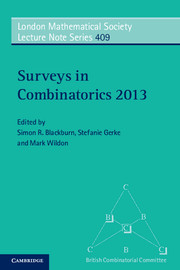Book contents
- Frontmatter
- Contents
- Preface
- 1 Graph removal lemmas
- 2 The geometry of covering codes: small complete caps and saturating sets in Galois spaces
- 3 Bent functions and their connections to combinatorics
- 4 The complexity of change
- 5 How symmetric can maps on surfaces be?
- 6 Some open problems on permutation patterns
- 7 The world of hereditary graph classes viewed through Truemper configurations
- 8 Structure in minor-closed classes of matroids
- 9 Automatic counting of tilings of skinny plane regions
- References
6 - Some open problems on permutation patterns
Published online by Cambridge University Press: 05 July 2013
- Frontmatter
- Contents
- Preface
- 1 Graph removal lemmas
- 2 The geometry of covering codes: small complete caps and saturating sets in Galois spaces
- 3 Bent functions and their connections to combinatorics
- 4 The complexity of change
- 5 How symmetric can maps on surfaces be?
- 6 Some open problems on permutation patterns
- 7 The world of hereditary graph classes viewed through Truemper configurations
- 8 Structure in minor-closed classes of matroids
- 9 Automatic counting of tilings of skinny plane regions
- References
Summary
Abstract
This is a brief survey of some open problems on permutation patterns, with an emphasis on subjects not covered in the recent book by Kitaev, Patterns in Permutations and words. I first survey recent developments on the enumeration and asymptotics of the pattern 1324, the final pattern of length 4 whose asymptotic growth is unknown, and related issues such as upper bounds for the number of avoiders of any pattern of length k for any given k. Other subjects treated are the Möbius function, topological properties and other algebraic aspects of the poset of permutations, ordered by containment, and also the study of growth rates of permutation classes, which are containment closed subsets of this poset.
Introduction
The notion of permutation patterns is implicit in the literature a long way back, which is no surprise given that permutations are a natural object in many branches of mathematics, and because patterns of various sorts are ubiquitous in any study of discrete objects. In recent decades the study of permutation patterns has become a discipline in its own right, with hundreds of published papers. This rapid development has not only led to myriad new results, but also, and more interestingly, spawned several different research directions in the last few years. Also, many connections have been discovered between permutation patterns and other research areas, both inside and outside of combinatorics, showcasing the fundamental nature of patterns in permutations and other kinds of words.
- Type
- Chapter
- Information
- Surveys in Combinatorics 2013 , pp. 239 - 264Publisher: Cambridge University PressPrint publication year: 2013
References
- 4
- Cited by

